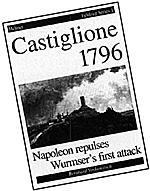
Author: Bernhard Voykowitsch
Pages: 96
Illustrations: 32 black and white reproductions of
period engravings and 51 photos of the area today (14 color).
Maps: 16, including
3 of the city and fortress of Mantua,
8 strategic, and 5 tactical showing
battalions, batteries, and regiments
in color). Footnotes: None
Appendices: 18
tables of organization, losses, etc.,
spread throughout the book, plus
four appendices at the end: The
Battlefields Today; Chronology of
the Campaign; Sources & A Guide
to Further Reading; and
Wargaming Castiglione.
Bibliography: None,
but the Sources appendix notes
files and records consulted for
primary documents in the archives
of Vienna and Paris, including
published unit histories for Austrian
regiments.
Index: None
Publisher: Helmet
Military Publications, Austria
Publication
Date: 1998
Binding:
Paper
(softbound)
ISBN: 3-901923-00-4
Price: $21.00
Summary: Voykowitsch's
study is a remarkable first effort for
a self-published book. It is an
excellent source of detailed
information in English about the
Austrian and French commanders
and units that fought during the first
few months of Napoleon
Bonaparte's reputation-building
campaign in northern Italy
Voykowitsch chronicles and
summarizes the first Austrian
attempt to relieve their forces under
siege in Mantua, culminating in the
battle of Castiglione in August,
1796.
Note: It must be stressed that this book is in English, as there has apparently been some confusion due to the fact the author /publisher is Austrian. While some of the English grammar is awkward in places, the text is efficient and easy to understand. The text has also been anglicized: Wurmser appears as Wurmser and most German and French accent marks are not used.
Many historians emphasize the importance of Napoleon's first field command in Italy in 1796-97, but the Austrian perspective during that period is often absent from most studies. What was their initial reaction to the rapid, early successes of this 26-year-old French general? What were the exact forces opposing the French? What precisely was the impact of the battles in northern Italy on what was then perceived to be the main theater of war in Germany? Author Voykowitsch does a credible job of explaining the campaign from the previously little-known Austrian viewpoint, and integrates it with more familiar details available about the French side.
The background to the campaign is explained briefly, starting with the French offensive in April, 1796, the rapid defeat of first the Piedmontese and then the Austrian army, and the pursuit of the Austrians across northern Italy and into the fortress at Mantua where a siege began in late May. Castiglione 1796 focuses on the first Austrian attempt to raise the siege and recapture their territory in Italy
The main sections of the book include: an outline of the siege of Mantua from June to July; a comparison of the opposing commanders (28 Austrian and one British; 28 French); a comparison of the opposing armies; a comparison of the rival plans and preparations; operations from July to August leading up to the battle of Castiglione; the battle fought on 5 August; the aftermath, retreat and pursuit; and a final accounting. There is also a brief description of the battlefields today, which, supported by 51 photographs, shows the actual terrain in ways no map alone can convey.
Voykowitsch explains how Wurmser wasted an 11,000-man advantage by splitting his army, also thereby allowing young general Bonaparte to defeat each part separately. More illuminating is the author's contention that although the Austrians would attempt several more times to save their forces trapped in Mantua, they would never again have the same quality of troops as during the Castiglione campaign.
Voykowitsch notes that subsequent Austrian armies were composed of weakened battalions, or battalions rebuilt with untrained recruits, or battalions put together from the remnants of several units. This helps explain why the French could parry every new Austrian offensive over the next five months. If the Austrians were operating with lower caliber units, it throws a different light upon Napoleon's initial repulse three months later at Arcola: Why did it take him three days to defeat such a patchwork Austrian army? Since the author intends to publish more of these "Feldzug Series" books, hopefully he will answer this question and offer more revelations.
Despite the small size of the book, it is literally crammed with information, including the fact that the battle was named by Napoleon after his headquarters location of the previous night. In reality, the actual battlefield lies six kilometers to the east overlapping the site of the battle of Solferino fought during Italian unification in 1859. Voykowitsch also considers previous works and cites primary sources when he disagrees with them. Castiglione 1796 is highly recommended to anyone interested in Napoleon's early career.
More Book Reviews
-
Book Review: Tactics and the Experience of Battle in the Age of
Napoleon
Book Review: Castiglione 1796
Book Review: Swords Around a Throne: Napoleon's Grande Armee
Book Review: History of the Waterloo Campaign
Back to Table of Contents -- Napoleon #13
Back to Napoleon List of Issues
Back to MagWeb Master Magazine List
© Copyright 1998 by Napoleon LLC.
This article appears in MagWeb (Magazine Web) on the Internet World Wide Web.
The full text and graphics from other military history magazines and gaming magazines are available at http://www.magweb.com
Order Napoleon magazine direct